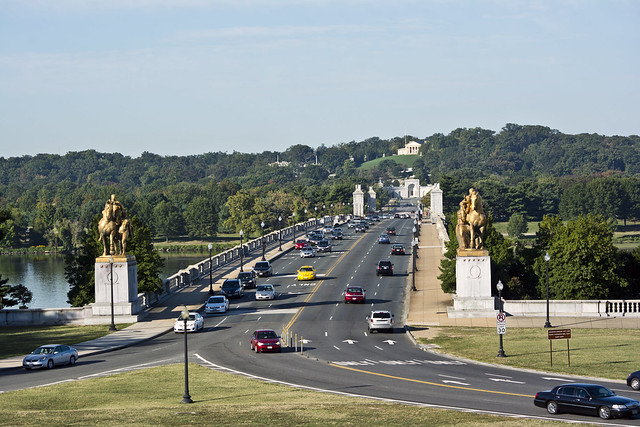- Name of the Bridge: Arlington Memorial Bridge
- Country/ State: United States, Washington, D.C.
- Address: 2912 Independence Ave SW, Washington, DC 20418, United States
- Built Year: 1922–1932
- Crosses: Potomac River
- Architectural style:
- Neoclassical, Central bascule, Arch bridge
- Architect: McKim, Mead, and White
- Opened: January 16, 1932
- Area: 16 ha
- Width: 94 feet
- Total length: 2,163 ft (659.3 m)
- Longest span: 65 m
- project's total cost: $500,000
- Toll: Free both ways
- Official website: https://www.nps.gov/gwmp/planyourvisit/memorialave.htm
See also: Arlington Cemetery in Washington DC, USA
Arlington Memorial Bridge
The Arlington Memorial Bridge between the District of Columbia and Virginia is considered to be the most beautiful in Washington. But it is also a symbolic bridge, it connects the memorial of Lincoln, the leader of the Northmen during the Civil War, and Arlington, where the estate of General Lee, who commanded the troops of the South, was located. This is a visible sign of reconciliation and unification of the country.
For the first time, Congress spoke of building a crossing of the Potomac River at this location back in 1886. Design proposals have been discussed for decades. In 1913, Congress passed a law that, in particular, required funding for the construction of the bridge in fulfillment of the so-called Macmillan plan (a project for the development of downtown Washington). However, the First World War began, the money was never allocated.
The case helped in 1921, United States President Warren Harding was on his way to the grand opening of the tomb of the unknown soldiers at Arlington Cemetery. There was a traffic jam on the 14th Street bridge that Harding was traveling on, and the President was stuck in it for three hours. The incident inspired him to petition Congress for $ 25,000 to build a new bridge, and the money was finally given. The project was developed by the architectural firm "McKim, Mead and White".
The neoclassical stone and steel arch bridge was opened in 1932 - at the time it was an example of the very rapid construction of such a long (652 meters) and heavy (2700 tons) drawbridge. True, the last time its central part rose in 1961 - since the Theodore Roosevelt Bridge, which is not a drawbridge, was built upstream, tall ships can no longer enter this part of the Potomac.
Arlington Memorial Bridge is decorated discreetly but elegantly - sculptures of eagles on pylons from the western entrance, reliefs with images of the same eagles, oak wreaths, bison, a granite balustrade ... Only two monumental sculptural groups by Leo Friedlander, installed in 1951, are striking year. Gilded bronze sculptures under the general title "The Art of War" are located at the eastern entrance. The group to the left is called "Valor" a woman carrying a shield accompanies the rider. The group on the right, "Sacrifice", is more complicated - it can be assumed that the woman is saying goodbye to the child whom she gave to the rider. It is believed that the woman symbolizes the Earth, and the horseman symbolizes Mars.
Nearby, north of the bridge, are two sculptural groups "The Art of Peace" by James Earl Fraser - "Music and Harvest" and "Aspiration and Literature". They were created back in the 1930s, but they were cast in bronze only in the early 1950s. It was in a pair with them that Friedlander sculpted his "Art of War".
However, the main decoration of the Arlington Memorial Bridge is still not the design, but the surrounding landscapes. It is for their sake that tourists who come to Washington are always advised to walk across the bridge. From here, there is a magnificent view on one side of the river - the Lincoln Memorial and the western end of the National Mall, on the other - Arlington House (General Lee's mansion) on a high hill
For information specific to travelers visit: https://www.nps.gov/gwmp/learn/management/amb-rehabilitation.htm or https://www.nps.gov/gwmp/learn/management/drivers.htm
Thanks for reading....


